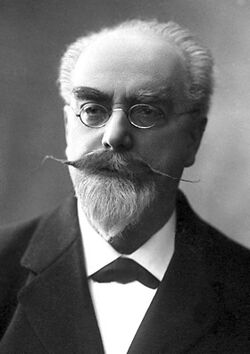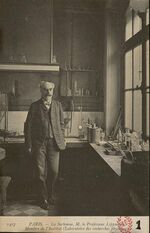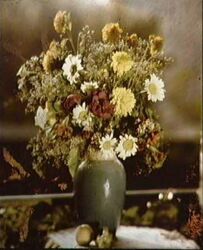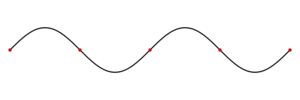Gabriel Lippmann
Topic: Biography
 From HandWiki - Reading time: 11 min
From HandWiki - Reading time: 11 min
Gabriel Lippmann | |
|---|---|
 Lippmann in 1908 | |
| Born | Jonas Ferdinand Gabriel Lippmann 16 August 1845 Bonnevoie/Bouneweg, Luxembourg (since 1921 part of Luxembourg City) |
| Died | 13 July 1921 (aged 75) SS France, Atlantic Ocean |
| Nationality | French |
| Alma mater | École Normale Supérieure |
| Known for | Lippmann photography Lippmann electrometer Electrowetting Integral photography Converse piezoelectric effect |
| Awards | Nobel Prize for Physics (1908) |
| Scientific career | |
| Fields | Physics |
| Institutions | Sorbonne |
| Doctoral advisor | Gustav Kirchhoff |
| Other academic advisors | Hermann von Helmholtz[1] |
| Doctoral students | Marie Curie |
Jonas Ferdinand Gabriel Lippmann (16 August 1845 – 13 July 1921) was a France -Luxembourgish physicist and inventor, and Nobel laureate in physics for his method of reproducing colours photographically based on the phenomenon of interference.[2] His parents were French Jews.
Early life and education
Gabriel Lippmann was born in Bonnevoie, Luxembourg (Luxembourgish: Bouneweg), on 16 August 1845.[3] At the time, Bonnevoie was part of the commune of Hollerich (Luxembourgish: Hollerech) which is often given as his place of birth. (Both places, Bonnevoie and Hollerich, are now districts of Luxembourg City.) His father, Isaïe, a French Jew born in Ennery near Metz, managed the family glove-making business at the former convent in Bonnevoie. In 1848, the family moved to Paris where Lippmann was initially tutored by his mother, Miriam Rose (Lévy), before attending the Lycée Napoléon (now Lycée Henri-IV).[4] He was said to have been a rather inattentive but thoughtful pupil with a special interest in mathematics. In 1868, he was admitted to the École normale supérieure in Paris where he failed the agrégation examination which would have enabled him to enter the teaching profession, preferring instead to study physics. In 1872, the French government sent him on a mission to Heidelberg University where he was able to specialize in electricity with the encouragement of Gustav Kirchhoff, receiving a doctorate with "summa cum laude" distinction in 1874.[5] Lippmann then returned to Paris in 1875, where he continued to study until 1878, when he became professor of physics at the Sorbonne.[6][7][8] At the Sorbonne he was teaching acoustics and optics.[9]
Career
Lippmann made several important contributions to various branches of physics over the years.
The capillary electrometer
One of Lippmann's early discoveries was the relationship between electrical and capillary phenomena which allowed him to develop a sensitive capillary electrometer, subsequently known as the Lippmann electrometer which was used in the first ECG machine. In a paper delivered to the Philosophical Society of Glasgow on 17 January 1883, John G. M'Kendrick described the apparatus as follows:
- Lippmann's electrometer consists of a tube of ordinary glass, 1 metre long and 7 millimetres in diameter, open at both ends, and kept in the vertical position by a stout support. The lower end is drawn into a capillary point, until the diameter of the capillary is .005 of a millimetre. The tube is filled with mercury, and the capillary point is immersed in dilute sulphuric acid (1 to 6 of water in volume), and in the bottom of the vessel containing the acid there is a little more mercury. A platinum wire is put into connection with the mercury in each tube, and, finally, arrangements are made by which the capillary point can be seen with a microscope magnifying 250 diameters. Such an instrument is very sensitive; and Lippmann states that it is possible to determine a difference of potential so small as that of one 10,080th of a Daniell. It is thus a very delicate means of observing and (as it can be graduated by a compensation-method) of measuring minute electromotive forces.[10][11]
Lippmann's PhD thesis, presented to the Sorbonne on 24 July 1875, was on electrocapillarity.[12]
Piezoelectricity
In 1881, Lippmann predicted the converse piezoelectric effect.[13]
Colour photography
Above all, Lippmann is remembered as the inventor of a method for reproducing colours by photography, based on the interference phenomenon, which earned him the Nobel Prize in Physics for 1908.[7]
In 1886, Lippmann's interest turned to a method of fixing the colours of the solar spectrum on a photographic plate. On 2 February 1891, he announced to the Academy of Sciences: "I have succeeded in obtaining the image of the spectrum with its colours on a photographic plate whereby the image remains fixed and can remain in daylight without deterioration."[3] By April 1892, he was able to report that he had succeeded in producing colour images of a stained glass window, a group of flags, a bowl of oranges topped by a red poppy and a multicoloured parrot. He presented his theory of colour photography using the interference method in two papers to the Academy, one in 1894, the other in 1906.[5]
The interference phenomenon in optics occurs as a result of the wave propagation of light. When light of a given wavelength is reflected back upon itself by a mirror, standing waves are generated, much as the ripples resulting from a stone dropped into still water create standing waves when reflected back by a surface such as the wall of a pool. In the case of ordinary incoherent light, the standing waves are distinct only within a microscopically thin volume of space next to the reflecting surface.
Lippmann made use of this phenomenon by projecting an image onto a special photographic plate capable of recording detail smaller than the wavelengths of visible light. The light passed through the supporting glass sheet into a very thin and nearly transparent photographic emulsion containing sub microscopically small silver halide grains. A temporary mirror of liquid mercury in intimate contact with the emulsion reflected the light back through it, creating standing waves whose nodes had little effect while their antinodes created a latent image. After development, the result was a structure of lamellae, a very fine fringe pattern in distinct parallel layers composed of submicroscopic metallic silver grains, which was a permanent record of the standing waves. Throughout the emulsion, the spacing of the lamellae corresponded to the half-wavelengths of the light photographed; λ/(2n), λ being the wavelength of light in air and n is the refractive index of the emulsion. Thus colour information was stored locally. The larger the separation between the fringes, the longer was the wavelength recorded from the image colour, red being the longest.[9]
The finished plate was illuminated from the front at a nearly perpendicular angle, using daylight or another source of white light containing the full range of wavelengths in the visible spectrum. At each point on the plate, light of approximately the same wavelength as the light which had generated the lamellae was strongly reflected back toward the viewer. Light of other wavelengths which was not absorbed or scattered by the silver grains simply passed through the emulsion, usually to be absorbed by a black anti-reflection coating applied to the back of the plate after it had been developed. The wavelengths, and therefore the colours, of the light which had formed the original image were thus reconstituted and a full-colour image was seen.[14][15][16]
In practice, the Lippmann process was not easy to use. Extremely fine-grained high-resolution photographic emulsions are inherently much less light-sensitive than ordinary emulsions, so long exposure times were required. With a lens of large aperture and a very brightly sunlit subject, a camera exposure of less than one minute was sometimes possible, but exposures measured in minutes were typical. Pure spectral colours reproduced brilliantly, but the ill-defined broad bands of wavelengths reflected by real-world objects could be problematic. The process did not produce colour prints on paper and it proved impossible to make a good duplicate of a Lippmann colour photograph by rephotographing it, so each image was unique. A very shallow-angled prism was usually cemented to the front of the finished plate to deflect unwanted surface reflections, and this made plates of any substantial size impractical. The size of his early photographs was 4 cm by 4 cm, increased later to 6.5 cm by 9 cm.[9] The lighting and viewing arrangement required to see the colours to best effect precluded casual use. Although the special plates and a plate holder with a built-in mercury reservoir were commercially available for a few years c. 1900, even expert users found consistent good results elusive and the process never graduated from being a scientifically elegant laboratory curiosity. It did, however, stimulate interest in the further development of colour photography.[16]
Lippmann's process foreshadowed laser holography, which is also based on recording standing waves in a photographic medium. Denisyuk reflection holograms, often referred to as Lippmann-Bragg holograms, have similar lamellar structures that preferentially reflect certain wavelengths. In the case of actual multiple-wavelength colour holograms of this type, the colour information is recorded and reproduced just as in the Lippmann process, except that the highly coherent laser light passing through the recording medium and reflected back from the subject generates the required distinct standing waves throughout a relatively large volume of space, eliminating the need for reflection to occur immediately adjacent to the recording medium. Unlike Lippmann colour photography, however, the lasers, the subject and the recording medium must all be kept stable to within one quarter of a wavelength during the exposure in order for the standing waves to be recorded adequately or at all.
Integral photography
In 1908, Lippmann introduced what he called "integral photography", in which a plane array of closely spaced, small, spherical lenses is used to photograph a scene, recording images of the scene as it appears from many slightly different horizontal and vertical locations. When the resulting images are rectified and viewed through a similar array of lenses, a single integrated image, composed of small portions of all the images, is seen by each eye. The position of the eye determines which parts of the small images it sees. The effect is that the visual geometry of the original scene is reconstructed, so that the limits of the array seem to be the edges of a window through which the scene appears life-size and in three dimensions, realistically exhibiting parallax and perspective shift with any change in the position of the observer.[17] This principle of using numerous lenses or imaging apertures to record what was later termed a light field underlies the evolving technology of light-field cameras and microscopes.
When Lippmann presented the theoretical foundations of his "integral photography" in March 1908, it was impossible to accompany them with concrete results. At the time, the materials necessary for producing a lenticular screen with the proper optical qualities were lacking. In the 1920s, promising trials were made by Eugène Estanave, using glass Stanhope lenses, and by Louis Lumière, using celluloid.[18] Lippmann's integral photography was the foundation of research on 3D and animated lenticular imagery and also on color lenticular processes.
Measurement of time
In 1895, Lippmann evolved a method of eliminating the personal equation in measurements of time, using photographic registration, and he studied the eradication of irregularities of pendulum clocks, devising a method of comparing the times of oscillation of two pendulums of nearly equal period.[4]
The coelostat
Lippmann also invented the coelostat, an astronomical tool that compensated for the Earth's rotation and allowed a region of the sky to be photographed without apparent movement.[4]
Brownian ratchet
In 1900, he proposed what is later called the Brownian ratchet, as a purely mechanical version of Maxwell's demon, purportedly showing that the kinetic theory of gas is incompatible with the second law of thermodynamics.[19][20]
Academic affiliations
Lippmann was a member of the Academy of Sciences from 8 February 1886 until his death, serving as its president in 1912.[21] In addition, he was a Foreign Member of the Royal Society of London, a member of the Bureau des Longitudes,[4] and a member of the Grand Ducal Institute of Luxembourg. He became a member of the Société française de photographie in 1892 and its president from 1896 to 1899.[22] Lippmann was one of the founders of the Institut d'optique théorique et appliquée in France. Lippmann was the President of the Société Astronomique de France (SAF), the French astronomical society, from 1903–1904.[23]
Honours
Lippmann was appointed a Knight of the Legion of Honour on 29 December 1881, promoted to Officer on 2 April 1894, to Commander on 14 December 1900, and to the dignity of Grand Officer on 6 December 1919.[24]
In Luxembourg City an Institute for fundamental scientific research was named after Lippmann (Centre de Recherche Public Gabriel Lippmann) which merged on 1 January 2015 with another major research centre to form the new Luxembourg Institute for Science and Technology (LIST).[25]
Personal life
Lippmann married the daughter of the novelist Victor Cherbuliez in 1888.[4] He died on 13 July 1921 aboard the steamer France while en route from Canada.[26]
See also
- Autostereoscopy
- Brownian ratchet
- Light field camera
- List of Jewish Nobel laureates
References
- ↑ "Gabriel Lippmann". Mathematics Genealogy Project. http://genealogy.math.ndsu.nodak.edu/id.php?id=177513.
- ↑ "Gabriel Lippmann | French physicist". 12 August 2023. https://www.britannica.com/biography/Gabriel-Lippmann#ref78915.
- ↑ 3.0 3.1 Gabriel Lippmann's colour photography : science, media, museums. Hanin Hannouch. Amsterdam. 2022. ISBN 978-94-6372-855-3. OCLC 1304814408. https://www.worldcat.org/oclc/1304814408.
- ↑ 4.0 4.1 4.2 4.3 4.4 "Gabriel Lippmann". Nobel Foundation. http://nobelprize.org/nobel_prizes/physics/laureates/1908/lippmann-bio.html.
- ↑ 5.0 5.1 Jacques Bintz, "Gabriel Lippmann 1845–1921", in Gabriel Lippmann: Commémoration par la section des sciences naturelles, physiques et mathématiques de l’Institut grand-ducal de Luxembourg du 150e anniversaire du savant né au Luxembourg, lauréat du prix Nobel en 1908 (Luxembourg: Section des sciences naturelles, physiques et mathématiques de l’Institut grand-ducal de Luxembourg en collaboration avec le Séminaire de mathématique et le Séminaire d’histoire des sciences et de la médecine du centre universitaire de Luxembourg, 1997), Jean-Paul Pier & Jos. A. Massard: éditeurs, Luxembourg 1997. Retrieved 4 December 2010.
- ↑ Josef Maria Eder, History of Photography, 4th ed. (New York: Dover, 1978; ISBN:0-486-23586-6), p. 668. (This Dover edition reproduces the Columbia University Press edition of 1945; the book was originally published in 1932 as Geschichte der Photographie.)
- ↑ 7.0 7.1 From Nobel Lectures, Physics 1901–1921, Elsevier Publishing Company, Amsterdam, 1967
- ↑ See also the extensive biography on The Nobel Prize in Physics 1908 page.
- ↑ 9.0 9.1 9.2 Bjelkhagen, Hans I. (2008). "Lippmann, Gabriel Jonas (1845–1921) French scientist and physicist". in Hannavy, John (in en). Encyclopedia of nineteenth-century photography (1st ed.). New York, NY: Routledge. pp. 132, 320, 647, 808, 862–3, 990–1, 1183, 1433–4. ISBN 978-0-415-97235-2. OCLC 123968757. https://www.worldcat.org/oclc/123968757.
- ↑ John G. M'Kendrick, "Note on a Simple Form of Lippmann's Capillary Electrometer useful to Physiologists".
- ↑ See also a similar description in German at "Kapillārelektromēter", Meyers Konversationslexikon, Verlag des Bibliographischen Instituts, Leipzig und Wien, 1885–1892. Retrieved 5 December 2010.
- ↑ "About Gabriel Lippmann". http://www.crpgl.lu/index.php?id=37&L=2.
- ↑ Lippmann, G. (1881). "Principe de la conservation de l'électricité" (in fr). Annales de chimie et de physique 24: 145. http://gallica.bnf.fr/ark:/12148/bpt6k348640.
- ↑ Bolas, T. et al: A Handbook of Photography in Colours, Marion & Co. (London, 1900):45–59 (Retrieved from archive.org on 11 February 2010)
- ↑ Wall, E. J.: Practical Color Photography, American Photographic Publishing Co. (Boston, 1922):185–199 (Retrieved from archive.org on 5 September 2010)
- ↑ 16.0 16.1 Klaus Biedermann, "Lippmann's and Gabor's Revolutionary Approach to Imaging", Nobelprize.org. Retrieved 6 December 2010.
- ↑ Lippmann, G. (2 March 1908). "Épreuves réversibles. Photographies intégrales". Comptes Rendus de l'Académie des Sciences 146 (9): 446–451. Bibcode: 1908BSBA...13A.245D. https://gallica.bnf.fr/ark:/12148/bpt6k3100t/f446.image. Reprinted in Benton "Selected Papers on Three-Dimensional Displays".
- ↑ Timby, Kim (2015). 3D and Animated Lenticular Photography : Between Utopia and Entertainment. Berlin: De Gruyter. pp. 81–84. ISBN 978-3-11-041306-9.
- ↑ "La théorie cinétique des gaz et le principe de Carnot" (in fr). Monatshefte für Mathematik und Physik 14 (1): A24. 1903-12-01. doi:10.1007/BF01706937. ISSN 1436-5081. https://doi.org/10.1007/BF01706937.
- ↑ Hoffmann, Peter M (2016-03-01). "How molecular motors extract order from chaos (a key issues review)". Reports on Progress in Physics 79 (3): 032601. doi:10.1088/0034-4885/79/3/032601. ISSN 0034-4885. PMID 26863000. Bibcode: 2016RPPh...79c2601H. https://iopscience.iop.org/article/10.1088/0034-4885/79/3/032601.
- ↑ "Les Membres de l'Académie des sciences depuis sa création (en 1666)" (in fr). Académie des sciences. http://www.academie-sciences.fr/membres/in_memoriam/in_memoriam_liste_alphabetique_L.htm.
- ↑ Daniel Girardin, "La photographie interférentielle de Lippmann, méthode parfaite et oubliée de reproduction des couleurs", published in DU, die Zeitschrift der Kultur, no 708 : Fotografie, der lange Weg zur Farbe, Juillet-août 2000. Musée de l'Élysée. (in French) Retrieved 6 December 2010.
- ↑ Bulletin de la Société astronomique de France, 1911, vol. 25, pp. 581–586
- ↑ "LIPPMANN, Jonas Ferdinand Gabriel". Government of the French Republic. https://www.leonore.archives-nationales.culture.gouv.fr/ui/notice/236048.
- ↑ Annuaire du Luxembourg 2015, publ. Editus, p264
- ↑ "Gabriel Lippmann, Scientist, Dies at Sea", The New York Times, 14 July 1921.
Further reading
- Gabriel Lippmann's colour photography : science, media, museums. Hanin Hannouch. Amsterdam. 2022. ISBN 978-94-6372-855-3. OCLC 1304814408. https://www.worldcat.org/oclc/1304814408.
- J.P. Pier & J.A. Massard (eds) (1997):Gabriel Lippmann: Commémoration par la section des sciences naturelles, physiques et mathématiques de l’Institut grand-ducal de Luxembourg du 150e anniversaire du savant né au Luxembourg, lauréat du prix Nobel en 1908. Luxembourg, Section des sciences naturelles, physiques et mathématiques de l’Institut grand-ducal de Luxembourg en collaboration avec le Séminaire de mathématique et le Séminaire d’histoire des sciences et de la médecine du centre universitaire de Luxembourg, 139 p.
- Lebon, Ernest, "Savants du jour : biographie, bibliographie analytique des écrits", comprenant Portrait de Gabriel Lippmann. – 1911. p. 70, Gauthier-Villars (Paris), 1909–1913.
- Isabelle Bergoend, Le Dagobert optique, Editions Thierry Marchaisse, 2015.
External links
| Wikimedia Commons has media related to: |
- Miss nobel-id as parameter including the Nobel Lecture, 14 December 1908 Colour Photography
- Gabriel Lippmann in Jewish Encyclopedia
- Centre de Recherche Public – Gabriel Lippmann
 |
 KSF
KSF




